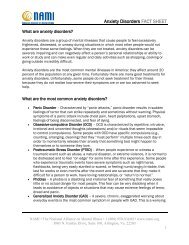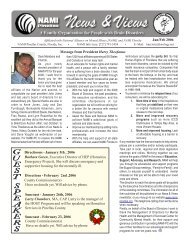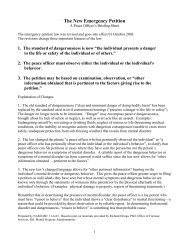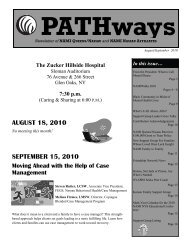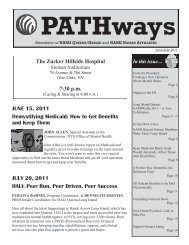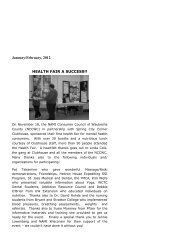Advocacy Committee Meets Congressman John Linder - NAMI
Advocacy Committee Meets Congressman John Linder - NAMI
Advocacy Committee Meets Congressman John Linder - NAMI
Create successful ePaper yourself
Turn your PDF publications into a flip-book with our unique Google optimized e-Paper software.
'%()! $$(!<br />
Loss. It’s something most of us<br />
are familiar with, or eventually<br />
will be at some point in our lives.<br />
Inevitably we are destined to<br />
experience the pain associated<br />
with the loss of a loved one for<br />
example. In fact, one might<br />
even say that loss is an integral<br />
part of life and the human<br />
condition. We cannot escape it.<br />
Subsequently, we must stand<br />
and face our grief and loss,<br />
following the rituals society has<br />
set forth for us, ultimately<br />
allowing us to come to terms<br />
with and make peace with the<br />
pain we have experienced,<br />
thereby allowing us to find a<br />
sense of closure.<br />
There is another type of loss,<br />
however, that often does not<br />
find closure. This is the sense<br />
of loss experienced by the<br />
families of individuals with<br />
mental disorders. This feeling<br />
of unresolved grief and loss is<br />
often referred to as “ambiguous<br />
loss.”<br />
In the case of a mental disorder,<br />
the family members of the<br />
diagnosed individual often feel<br />
as though they have lost that<br />
individual to the disorder.<br />
Essentially the person they<br />
knew is dead, replaced by a<br />
stranger with their loved one’s<br />
face. The sense of grief and<br />
loss experienced by the family<br />
members of an individual with a<br />
mental disorder often goes and<br />
remains unrecognized by others<br />
around them. This leads to a<br />
feeling of “ambiguous loss.”<br />
Ambiguous loss may be defined<br />
in three different ways: 1)The<br />
loss is characterized by a lack of<br />
"!# $%! !&<br />
clarity or confusion surrounding<br />
the loss itself. There is an<br />
absence of certainty regarding<br />
exactly what is happening, or<br />
when the uncertainty may end.<br />
The events surrounding this<br />
type of loss are frequently<br />
unclear; the status of the person<br />
is uncertain, and the return of<br />
the person is hoped for, but<br />
ultimately unknown. 2)The<br />
event of the loss is clear, but the<br />
perception of the loss is<br />
unclear. The loss itself is<br />
basically clear, but the family<br />
may be unwilling to accept the<br />
loss. An example of this is a<br />
physically present person who is<br />
psychologically isolated from his<br />
or her family due to a mental<br />
disorder. This isolation is the<br />
result of the family’s inability to<br />
accept the nature of the<br />
individual’s disorder. 3)The loss<br />
is unclear because it is not<br />
recognized, accepted, validated,<br />
or ritualized by society. These<br />
types of losses are also known<br />
as “disenfranchised losses.”<br />
The absence of societal rituals<br />
or supports exacerbates the<br />
sense of uncertainty and<br />
ambiguity due to a general lack<br />
of support from the community<br />
at large.<br />
The psychological absence or<br />
differences in the mental<br />
faculties of the diagnosed<br />
individual frequently perpetuate<br />
the feelings of loss among<br />
family members. Loss of the<br />
diagnosed individual as the<br />
family knew him or her, loss of<br />
the hopes and dreams of the<br />
person the individual could and<br />
should have been, and the<br />
changes and disruptions of the<br />
individual’s and family’s life and<br />
relationships all contribute to the<br />
family’s sense of loss and grief.<br />
The family’s grief is further<br />
intensified by the societal stigma<br />
so often attached to mental<br />
illness. Additionally, family<br />
members are constantly<br />
reminded of their loss as they<br />
see the diagnosed individual<br />
each day. All of these aspects<br />
ultimately combine with the fact<br />
that there are no symbolic<br />
rituals that ordinarily support a<br />
clear loss – such as a funeral<br />
following the death of a loved<br />
one. The lack of any societal<br />
customs surrounding the sense<br />
of loss associated with mental<br />
illness leaves the family in a<br />
state of limbo. The family’s<br />
experience remains unverified<br />
by extended family members,<br />
friends, and the community at<br />
large, so that there is little or no<br />
validation of what they are<br />
experiencing and feeling. This<br />
creates a sense of isolation in<br />
which family members feel<br />
unsupported, separated,<br />
unheard, or even dismissed. As<br />
a result, feelings of anger,<br />
frustration, sadness,<br />
disappointment, and guilt begin<br />
to build up as the family<br />
members either begin to blame<br />
themselves or the diagnosed<br />
individual. This leads to feelings<br />
of disbelief, of things being<br />
unreal and not wanting to know<br />
and not wanting to believe along<br />
with wishing that things were not<br />
true. There is often a strong<br />
yearning that things could go<br />
back to the way they were<br />
before.<br />
The sense of isolation<br />
!,<br />
(Continued on page 6)





